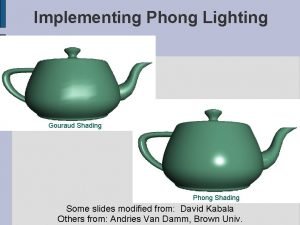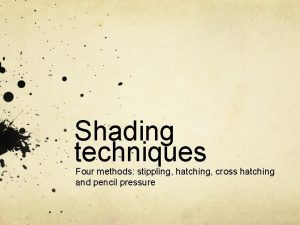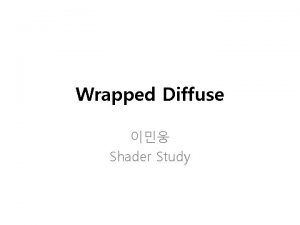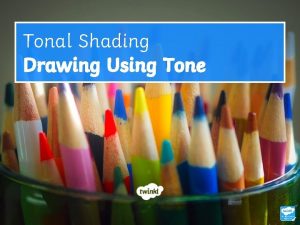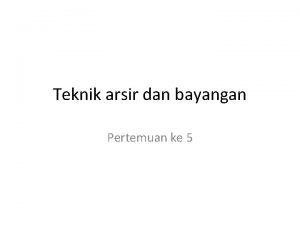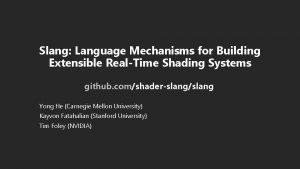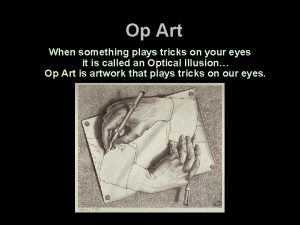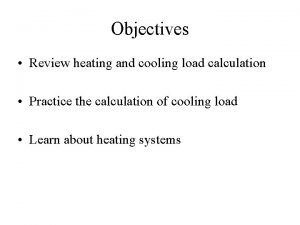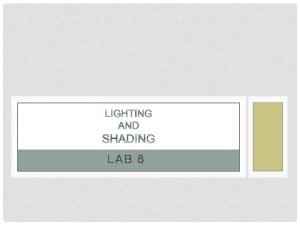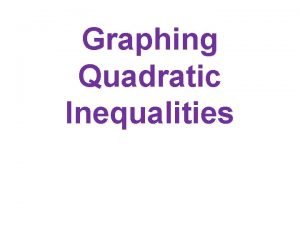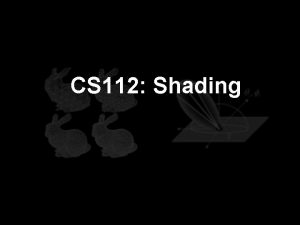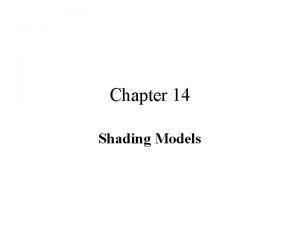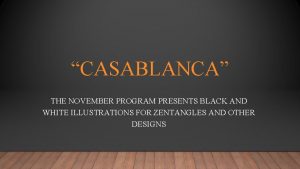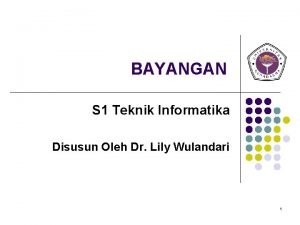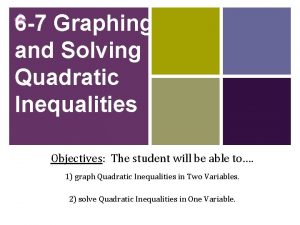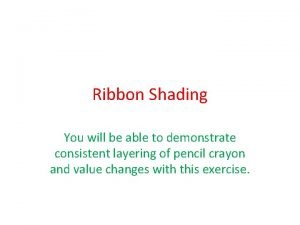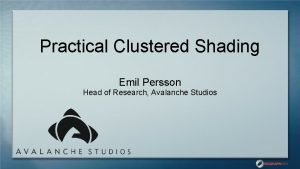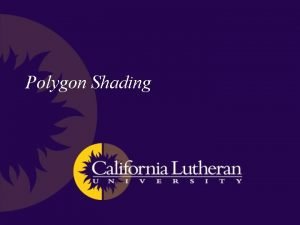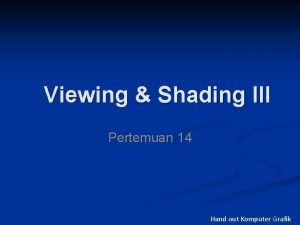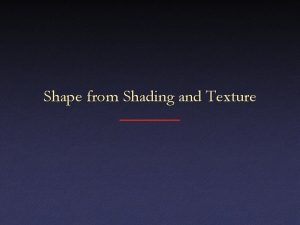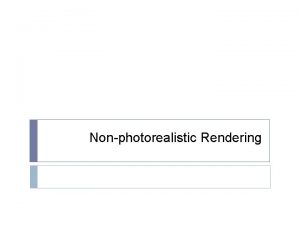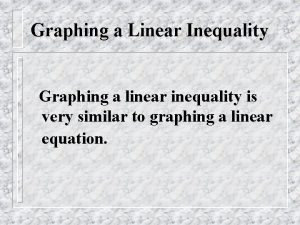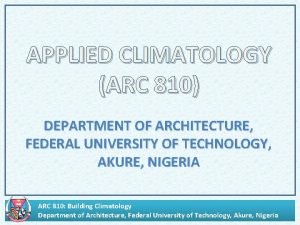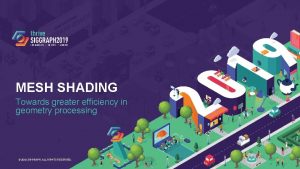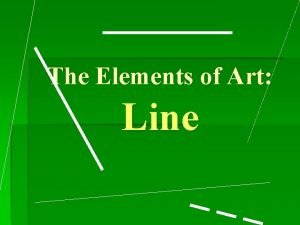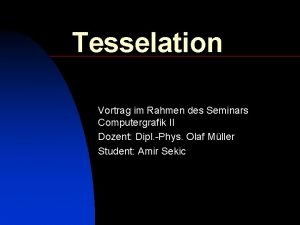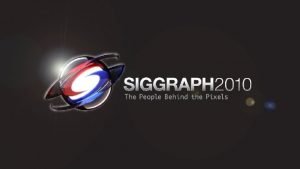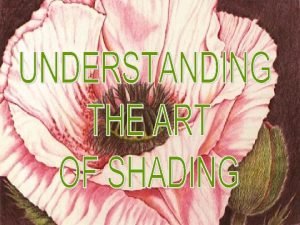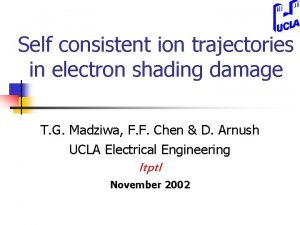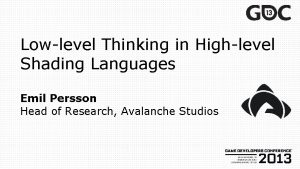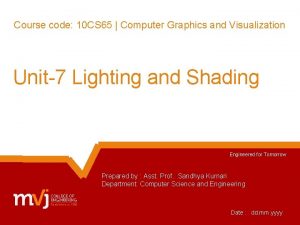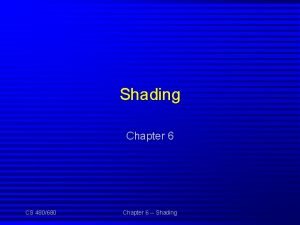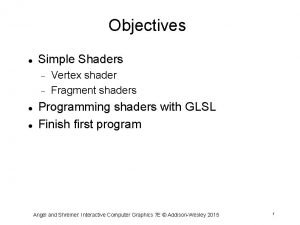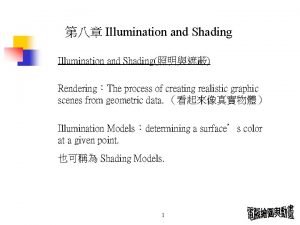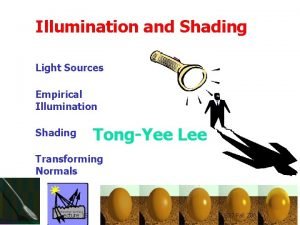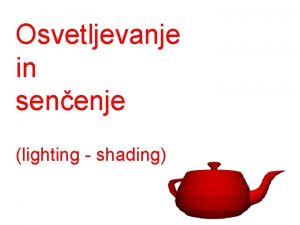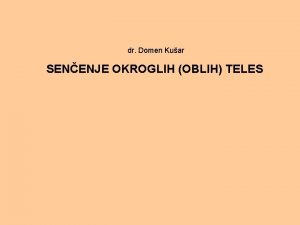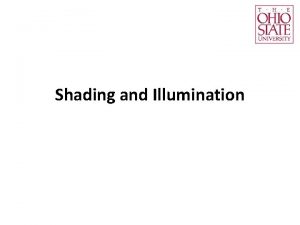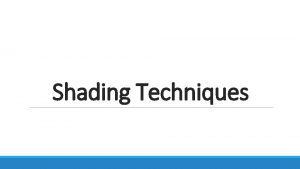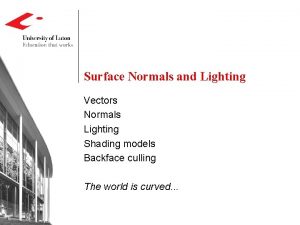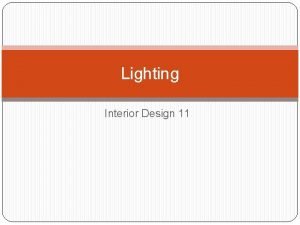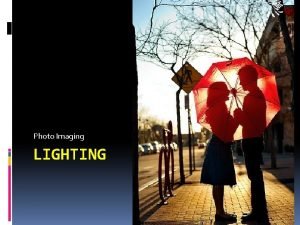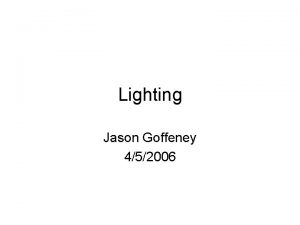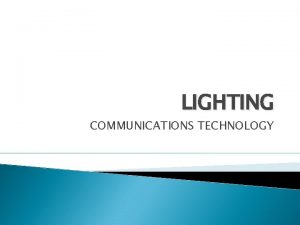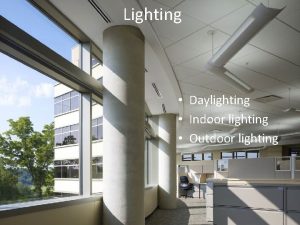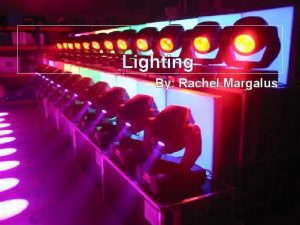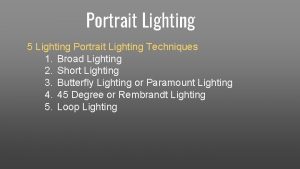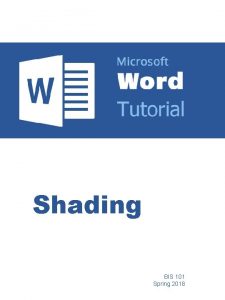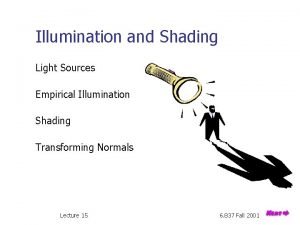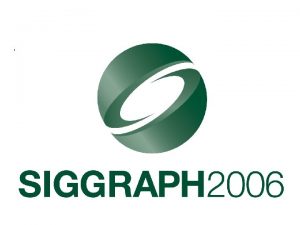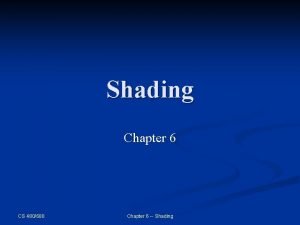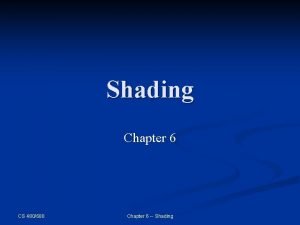Osvetljevanje in senenje lighting shading Osvetljevanje Two components





































- Slides: 37

Osvetljevanje in senčenje (lighting - shading)

“Osvetljevanje” § Two components: § Lighting Model or Shading Model - how we calculate the intensity at a point on the surface § Surface Rendering Method - How we calculate the intensity at each pixel

Lastnosti snovi § § § Ambient color Diffuse color Specular color Shininess Color of emitted light

Modeli osvetljevanja § Ambient § Normals don’t matter § Lambert/Diffuse § Angle between surface normal and light § Phong/Specular § Surface normal, light, and viewpoint § Rendering Equation (Kajiya)

Svetloba okolja (ambient color) § Affects the overall color of the object § Is most noticeable where an object receives no direct light § Total ambient reflectance is affected by global ambient light and ambient light from all light sources

Svetloba okolja (ambient color) § It represents the approximate contribution of the light to the general scene, regardless of location of light and object § Indirect reflections that are too complex to completely and accurately compute § Iambient = color

Difuzni odboj § Plays an important role in the color you perceive for an object § Is affected by the color of the incident diffuse light and the angle of the incident light relative to the normal direction § Viewer position doesn’t affect diffuse reflection

Osvetlitev površine – svetlost predmeta

Difuzni odboj § Contribution that a light has on the surface, regardless of viewing direction. § Diffuse surfaces, on a microscopic level, are very rough. This means that a ray of light coming in has an equal chance of being reflected in any direction.

Model difuzne svetlobe § Lambert’s Law The intensity of the light reflected from a perfect diffuser, Id, is proportional to the cosine of the angle between the light source direction and the normal to the surface. m s v and P pd : diffuse reflection coefficient

Lambertov kosinusni zakon § Diffuse surfaces follow Lambert’s Cosine Law § Lambert’s Cosine Law - reflected energy from a small surface area in a particular direction is proportional to the cosine of the angle between that direction and the surface normal. § Think about surface area and # of rays

Zrcalni odboj § Specular contribution can be thought of as the “shiny highlight” of a plastic object. N L R V

Bleščeči in motni predmeti

Phongov Model § An approximation is sets the intensity of specular reflection proportional to (cos )shininess § Ispecular = ks. Ilight (cos )shininess = ks. Ilight (V. R)shininess

Phongov model senčenja

Phongov model The amount of light reflected is greatest in the direction of perfect mirror reflection. At nearby angle, the amount of reflected light, Isp, varies according to cos f( ). r m s v and P ps : specular reflection coefficient

Kombinacija svetlobe § Light seen by the viewer = § Ambient light + Diffuse light + Specular light Open. GL allows you to specify different intensities for ambient, difuse and specular light sources Isa, Isd, Isp : set for each light in the environment pa, pd, ps : set for each material in the environment

Ambientna + difuzna + zrcalna

Žarenje (emission) § Make an object appear to give off light § Examples: lamps, street lights, etc.

Slabljenje (attenuation) § One factor we have yet to take into account is that a light source contributes a higher incident intensity to closer surfaces. § The energy from a point light source falls off proportional to 1/d 2.

RGB vrednosti za luči in snov § RGB values for lights indicate light intensity § RGB values for materials indicate reflected proportions of those colors

Dodajanje barve

Senčenje (shading) Shading is how we “color” a triangle.

Senčenje (shading) § § Flat shading Accentuates the individual polygons Smooth shading Smooths the edges between polygons – Phong shading – Gourand shading

Modeli senčenja (direktna svetloba) § Flat Shading § Compute Phong lighting once for entire polygon § Gouraud Shading § Compute Phong lighting at the vertices and interpolate lighting values across polygon § Phong Shading § Compute averaged vertex normals § Interpolate normals across polygon and perform Phong lighting across polygon

Plosko, konstantno senčenje § Constant Intensity or Flat Shading § One color for the entire triangle. Color is computed for one vertex and assigned to entire polygon § Fast § Good for some objects § What happens if triangles are small? § Sudden intensity changes at borders § Specular highlights are rendered poorly

Mehko senčenje (Gouraud) § Color is linearly interpolated from vertex points § Specular highlights appear interpolated

Gouraudovo senčenje § Intensity Interpolation Shading § Calculate lighting at the vertices. Then interpolate the colors as you scan convert § Relatively fast, only do three calculations

Gouraudovo senčenje

Slabo povprečenje verteksov

Mehko senčenje (Phong) § Phong § Interpolate normal vectors for each point on the face of an object § Better realism but more computationally expensive

Phongovo senčenje § Phong shading is not the same as Phong lighting, though they are sometimes mixed up § Phong lighting: the empirical model we’ve been discussing to calculate illumination at a point on a surface § Phong shading: linearly interpolating the surface normal across the facet, applying the Phong lighting model at every pixel § Same input as Gouraud shading § Usually very smooth-looking results: § But, considerably more expensive

Phongovo senčenje § Interpolate the normal, since that is the information that represents the “curvature” § Linearly interpolate the vertex normals. For each pixel, as you scan convert, calculate the lighting per pixel. § True “per pixel” lighting

Primerjava Gouraud: Phong

Senčniki (Shaders) § Local illumination quite complex § § § § Reflectance models Procedural texture Solid texture Bump maps Displacement maps Environment maps Need ability to collect into a single shading description called a shader Shaders also describe § lights, e. g. spotlights § atmosphere, e. g. fog

Senčenje v realnem času § Moore’s law: CPU power doubles every 18 months § Advances in materials § Advances in methods § Advances in marketing § Graphics version: GPU power doubles every 6 months § Supports more sophisticated shading, though in unexpected ways (e. g. strange uses of the texture maps)

Peercy, Olano, Airey , Ungar, "Interactive Multi-Pass Programmable Shading", SIGGRAPH 2000
 Gouraud vs phong shading
Gouraud vs phong shading Stipple shading technique
Stipple shading technique Half lambert shading
Half lambert shading Tone shading
Tone shading Teknik arsir bayangan
Teknik arsir bayangan Slang shader
Slang shader Op art blobs
Op art blobs Shading coefficient
Shading coefficient Shading ms word
Shading ms word Cl_smooth
Cl_smooth Pictorial sketch engineering
Pictorial sketch engineering Shading quadratic inequalities
Shading quadratic inequalities Shading
Shading Constant intensity shading
Constant intensity shading Casablanca black and white
Casablanca black and white Shading dalam menggambar terdiri dari dua intensitas
Shading dalam menggambar terdiri dari dua intensitas How to graph quadratic inequalities
How to graph quadratic inequalities Complete the venn diagram.
Complete the venn diagram. Ribbon shading
Ribbon shading Clustered shading
Clustered shading Polygon shading
Polygon shading Shading dalam komputer adalah
Shading dalam komputer adalah Shape from shading
Shape from shading Gooch shading model
Gooch shading model Inequality graphing rules
Inequality graphing rules Shading mask protractor
Shading mask protractor Cyril crassin
Cyril crassin Element of line
Element of line Was ist tesselation
Was ist tesselation Siggraph
Siggraph Shading light to dark
Shading light to dark Electron shading effect
Electron shading effect Rcp hlsl
Rcp hlsl Engineered shading
Engineered shading 480680
480680 Fragment shading
Fragment shading Shahing
Shahing Gourand shading
Gourand shading
